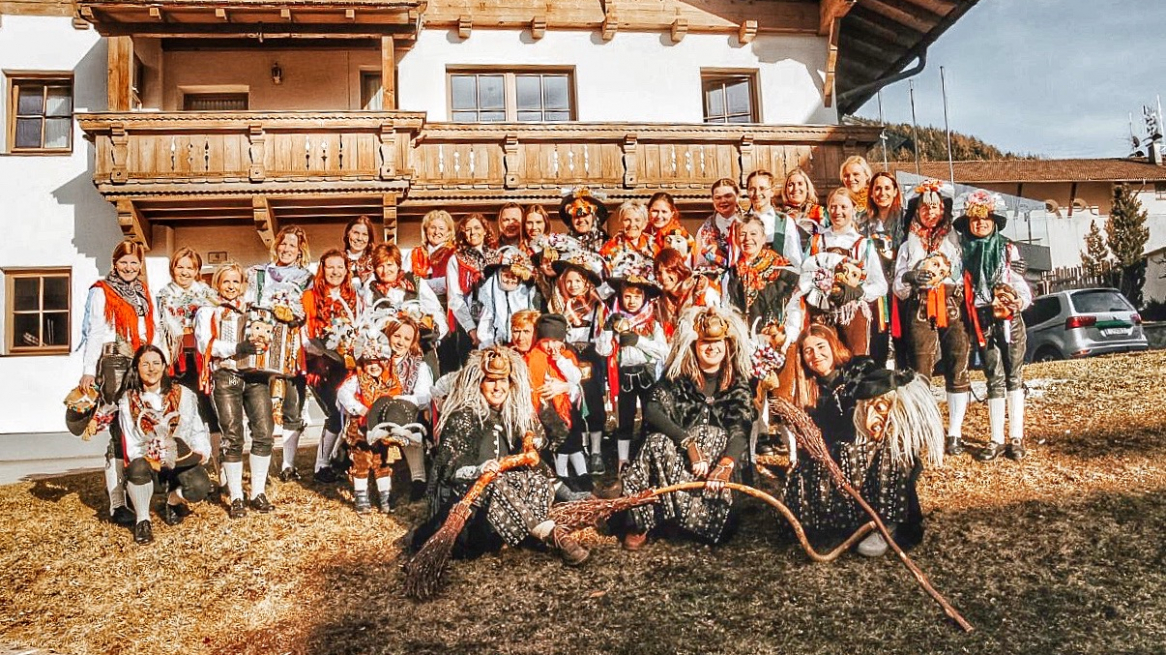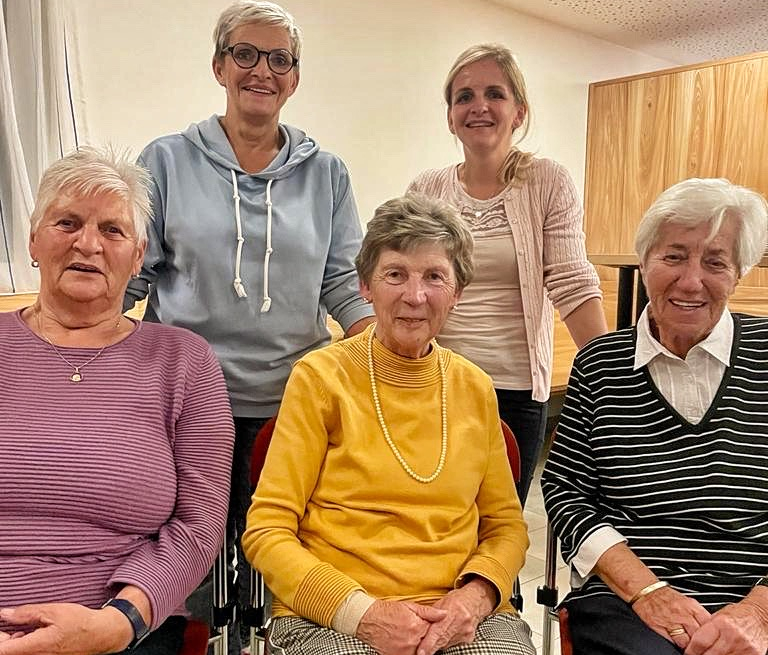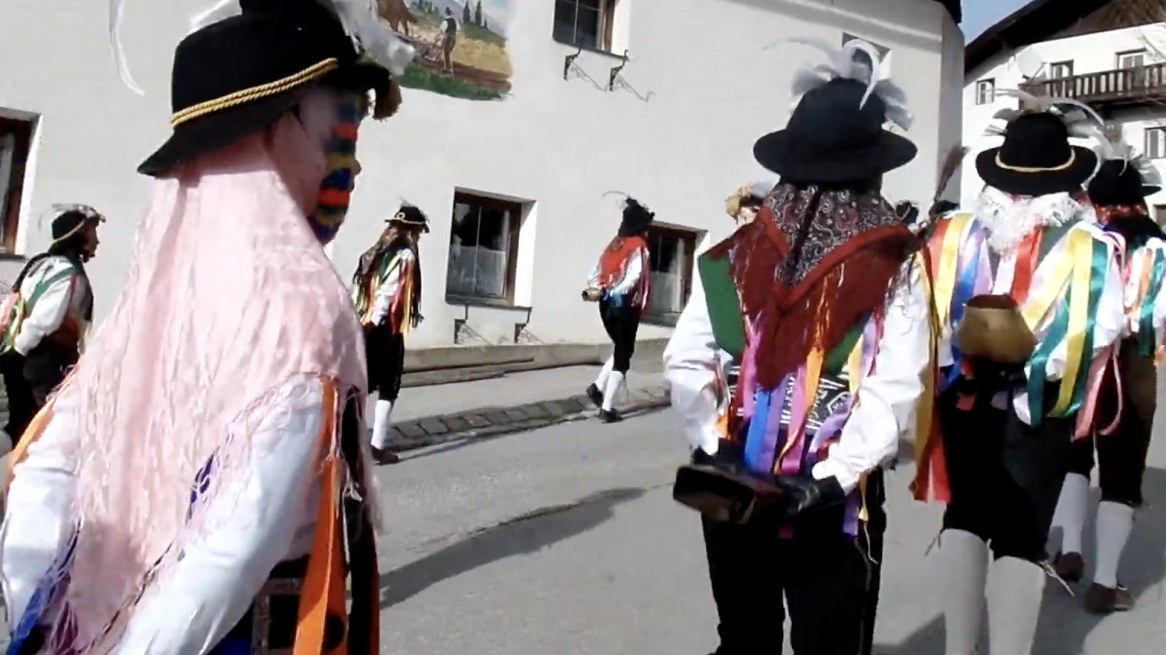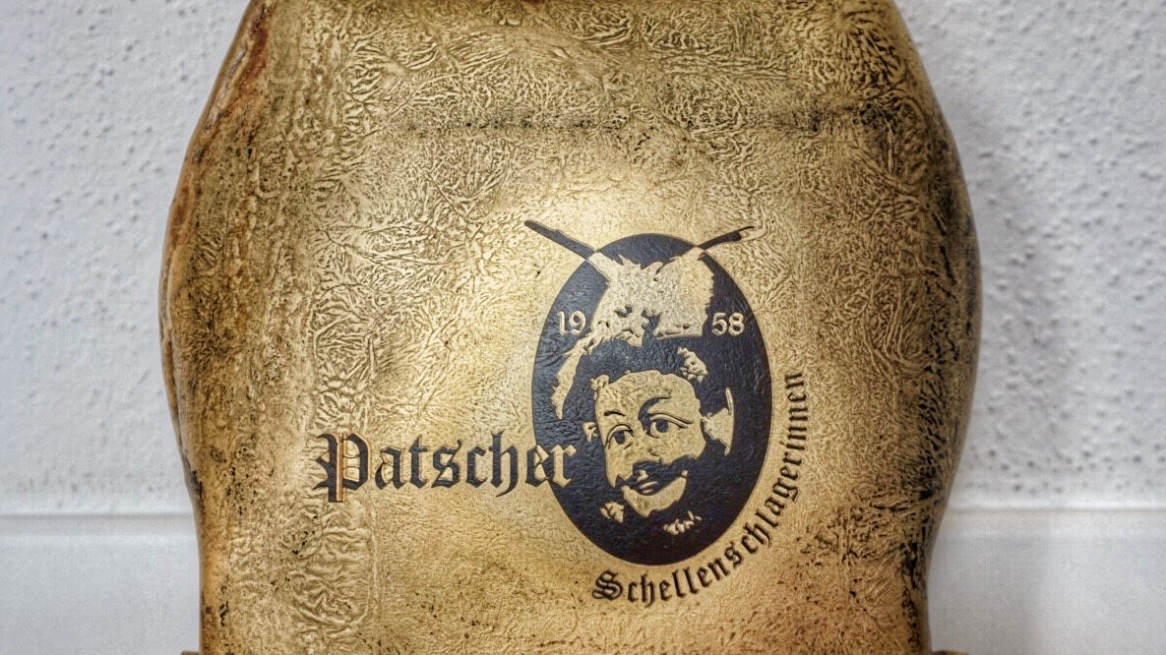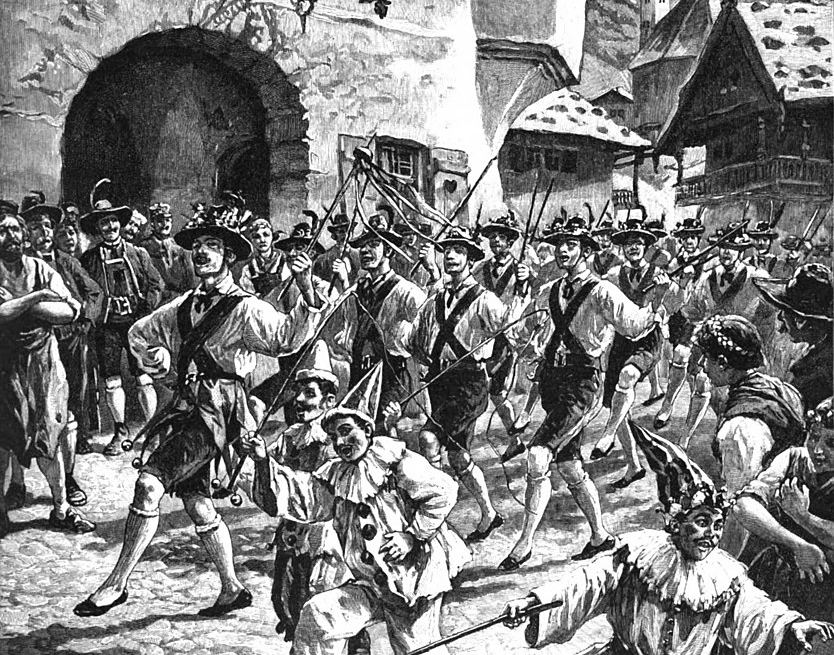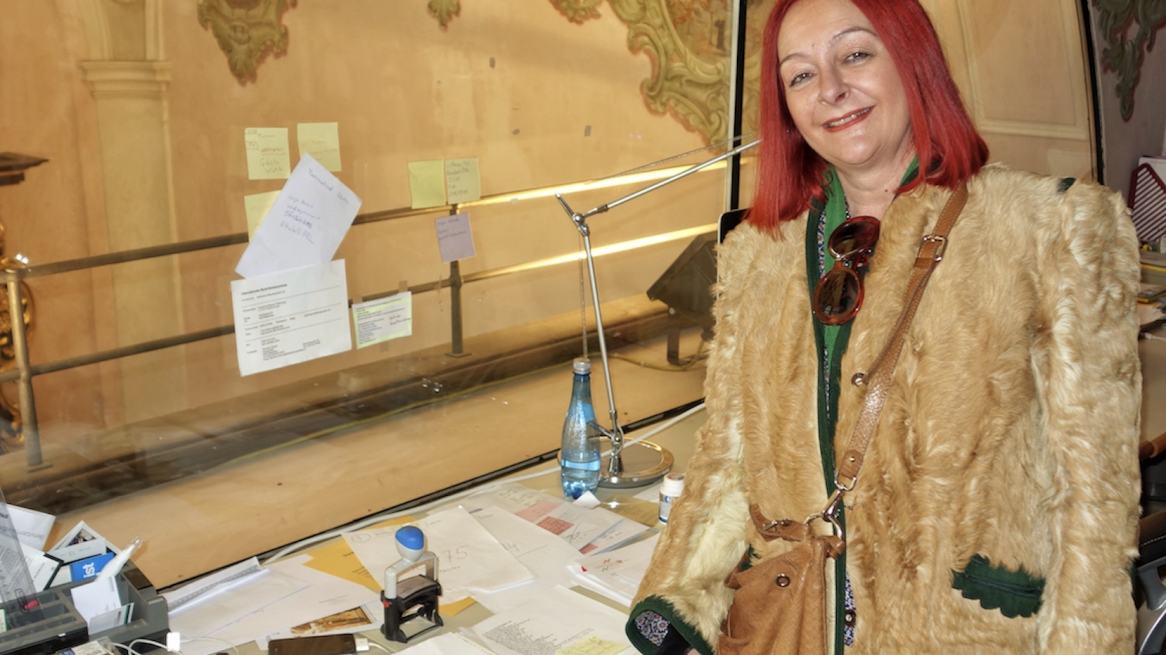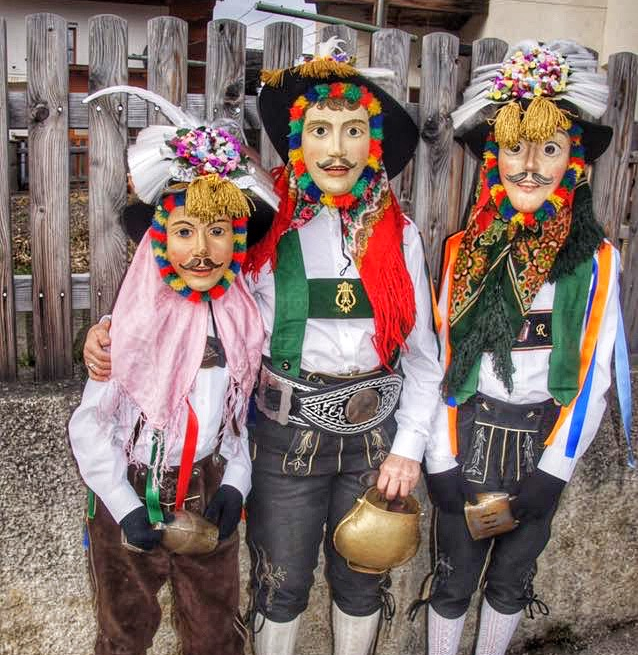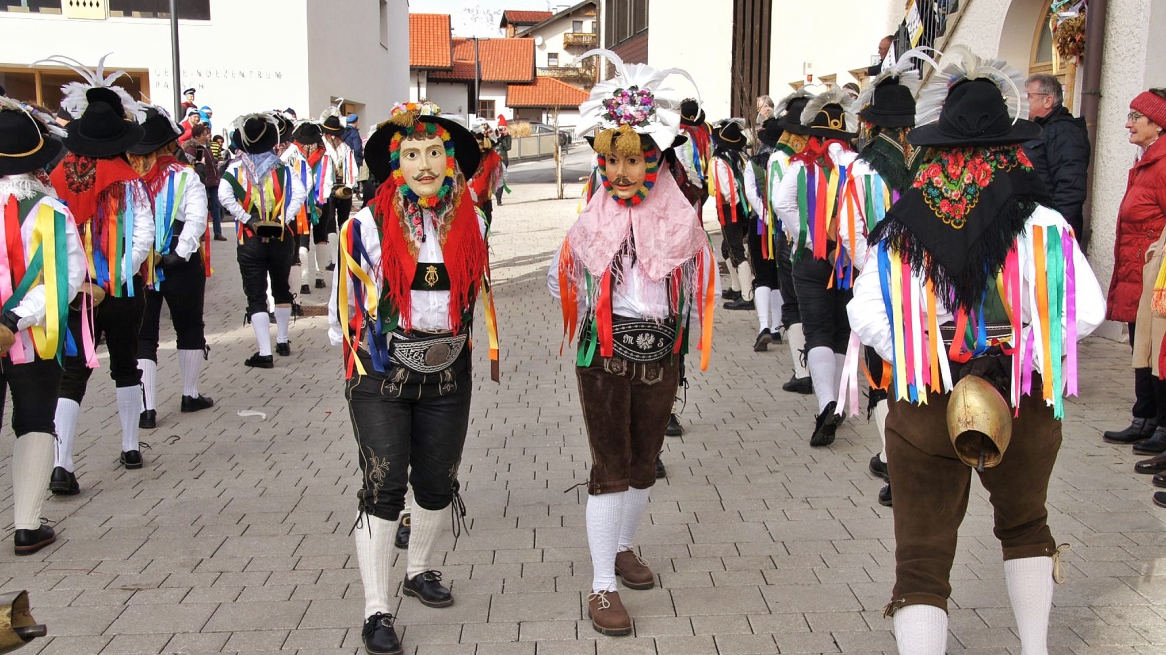
Inclusion in the Austrian UNESCO Intangible Cultural Heritage List is not an everyday honor. However, this is exactly what the Patscher Schellenschlagerinnen have achieved. It not only honors their cultivation of an age-old village custom, but also the women's commitment and dedication to preserving the custom and carrying it forward in the village community. If the Schellenschlager custom had been lost in Patsch, it would probably have been lost long ago.
They are now part of the UNESCO cultural heritage: the Patscher Schellenschlagerinnen..: Patscher Schellenschlagerinnen
It began with a spectacular 'conquest'
When in 1958 the men in the municipality of Patsch could not get their act together to practice the traditional Schellenschlagen on Mischief Thursday, women filled the carnival vacuum virtually overnight. They hijacked the custom, although women (to this day) are not allowed to play an active role in carnival in Tyrol. Erna Seeber, Mimi Span, Anni Töchterle, Regina Knoflach, Sophie Troger and Traudl Knoflach quickly procured the necessary equipment in strict secrecy and paraded through the village in disguise, thus unrecognized as "Weiberleut" (women's folk) and ringing bells.
This photo shows the concentrated female power of Patsch: Erna Seeber, Anni Mittermair and Maria Span (front, from left) as well as Evi Falgschlunger and 'presswoman' Claudia Lackner (back, from left). Erna Seeber and Maria Span were part of the 'women's regiment' that 'conquered' Patscher Schellenschlager in 1958. Image: Patscher Schellenschlagerinnen
While the population puzzled over who was hiding behind the masks, and even suspected that men from neighboring towns Lans or even Sistrans were hiding under the disguises, the Schellenschlagerinnen sniffed the schnapps offered to them without contradiction. One after the other - they wanted to conceal nevertheless that not alcohol-resistant men behind the masks stuck, and were nevertheless the spectators eager to inquire by means of alcoholic attention, who hid itself then now behind the disguise. When the masks were finally lifted, many men did not like it at all. More still: Their displeasure was large over it. Many of the horrified men rubbed their eyes when, to make matters worse, they realized that their wives had also taken part.
The Schellenschlagerinnen during one of their parades on Mischief Thursday. Image: Patscher Schellenschlagerinnen
The church kept women away from the carnival
Women in the carnival? Not in Tyrol. The church, especially the Jesuits, had kept women away from the carnival for decades, even centuries. Sin, they preached, always lurked everywhere when women dressed up. Men were obviously much more resistant to devilish temptations.
But things really took off in 1960 with the bell-ringing female patschers. The first 'activists' of this real 'Weiberfasnacht' were joined by more and more young and young-at-heart women of the Wipptal community. "Today," says Claudia Lackner, quasi the press spokeswoman of the group, proudly, "our club has between 60 and 70 members. And that with our 1,000 inhabitants."
A '60s clamp' of the Schellenschlagerinnen from Patsch, forged of course. They simply sound better. Image: Falgschlunger
Initially, the Schellenschlagerinnen invited a specialist - a man - to teach the group the secrets of the Schellenschlagens as a 'Vorhupfer'. The vanguard sets the pace and pulls the Schellenschlagerinnen forward. When the single man retired, it was then witches who led the bell-ringing procession from 2009 onwards. Of course, there is always the possibility of coming back to the ‚Bujazzl‘ if someone is found for this role.
In a historical depiction of Schellenschlager from 1899, it can be seen that three Bujazzln hopped ahead of Schellenschlägern (at that time they were still men). Image: Wikipedia
Schemen- and Schleicherlauf are relatives
The Schellenschlagen is actually related to the Schemen- or Schleicherlauf of the Tyrolean Upper Inn Valley. Similar to the Schemen and Schleicher, the Schellenschlagerinnen move forward together in time, their movements are similarly choppy as those of the Schemen.
The Schellenschlagen in the Innsbruck Mittelgebirge as in Igls, Lans, Sistrans and Patsch actually shows no common tradition and is therefore seemingly incoherent. Not so the clothes and the Larven (masks), which correspond to those of the elegantly and nobly dressed ‚Schiane Gian‘ carnival figures.
Mostly the Schellerinnen parade in pairs. A woodenlarve hat decorated with two ‚Giggl‘ feathers, glass feathers, colorful baubles, leaves, flowers and mirrors and a costume of white shirts with colorful ribbons, shoulder scarves and Kniebund leather pants with satchel is their distinctive mark. The bell is not hung around the neck, but held with both hands on the handle behind the back and rung. In the case of Patscher Schellenschlagerinnen, these are forged bells, which have a pleasantly different sound from cheap pressed bells.
Dr. Petra Streng, director of the Augustinermuseums in Rattenberg and folklorist of my choice, scatters roses to the women of Patsch in any case: "They have proven with a perfect organization that women have regained their active status in the carnival." The fact that the 'Weiberleit' are largely excluded from active carnival organization in Tyrol is a fact that cannot be explained logically, says Streng: "In the account books of Sigmund the Coin Rich, notes for a 'fee' for women in carnival appear."
For the renowned folklorist Dr. Petra Streng the Patscher Schellenschlagerinnen have 'role model function'. Image: Kräutler
Well, those who are familiar with carnival history may think: Sigmund was also a 'Weibeler' who was the father of an estimated 50 illegitimate children. Streng points out, however, that there is also evidence of the so-called Weiberfasnacht in Tyrol. "Various attempts are made to portray this custom as imported from Germany," she says. "But there are records from the 16th century, where there is talk of the Weiberfasnacht on Mischief Thursday in Ladis in Oberen Gericht. There, all male residents are even seriously warned not to go out on the streets or even into inns at night. Because there the women's regiment rules, which is by no means squeamish with the men"
Sigmund the Rich in Coins was apparently enthusiastic about women in the carnival. Here he is depicted at the Golden Roof. Image: Kräutler
Also as a social "moral image" the Patscher Schellenschlagerinnen show role model function, means Streng: "A supposedly male-dominated custom bastion was conquered or reconquered - and this to the good pleasure of the village and beyond. They show a male domain the ‚Trutzfeder‘, that is, they have ‚Schneid‘ (Tyrolean for courage) and confirm in their appearance that the woman belongs actively in the Fasnacht."
The UNESCO honor is already having its first positive effects. By being included in the Intangible Cultural Heritage List, the Schellenschlagerinnen are now involved in the „IKE goes ASPnet: Integration des Immateriellen Kulturerbes in die schulische Bildung“ project, working together with a vocational school for mechanical, production engineering and electronics in Vienna. The fact that media interest has therefore grown rapidly seems logical and gives many women in Tyrol the courage to also get involved in the male domain of Fasnacht.
"In addition," says the folklorist Petra Streng, "the model character for other customs of and with women is not to be underestimated."
Nothing remains to be added to this.
Event information
Who wants to experience the Patscher Schellenschlagerinnen quasi live and at the original place, this can do on 16 February, thus on the Unnsinnigen Thursday, 2023 in Patsch.
Rate this article
Show me the location on the map
A volunteer at the "Schule der Alm" alpine farming school, cultural pilgrim, Tyrol aficionado and Innsbruck fan.
Similar articles
The Ferdinandeum regional museum is open until June 30, 2024, with exhibitions and events. Then a…
A purely Tyrolean film project aims to shed new light on the novel story of probably…
With the Alpine Jitterbugs, Innsbruck has a club that is passionately dedicated to swing dancing. The Alpine…
The first edition of the Innsbruck Winter Dance Festivals has been a success, says…

